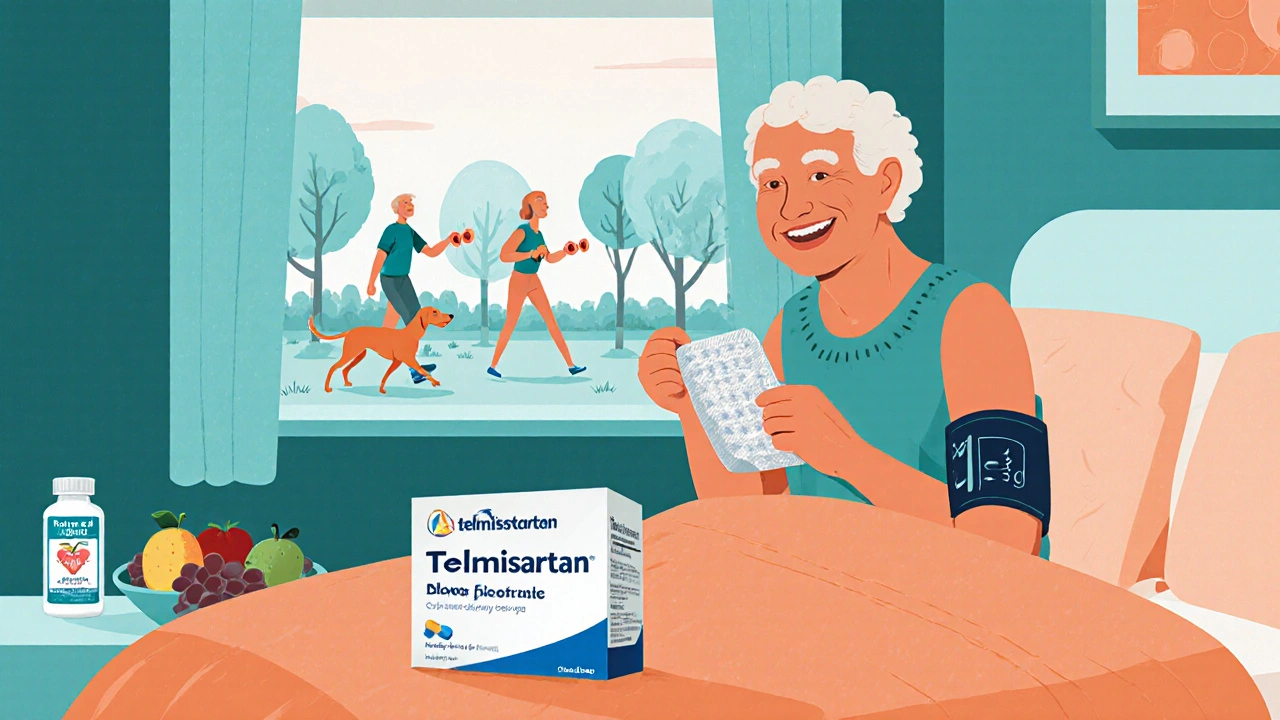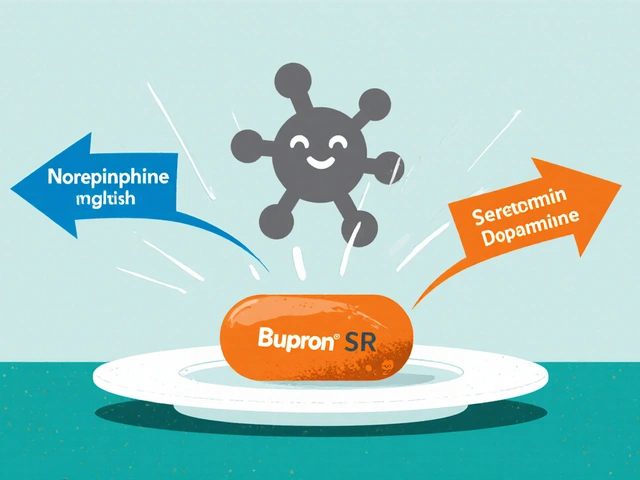
Stroke Risk Reduction Calculator
Your Blood Pressure
Enter your current blood pressure reading to see potential stroke risk reduction with telmisartan
How It Works
Based on clinical evidence from major studies (ONTARGET, PRoFESS, TRANSCEND), telmisartan has been shown to reduce stroke risk by approximately 14-15% in patients with high cardiovascular risk when used as part of blood pressure management.
Telmisartan typically reduces systolic pressure by about 12 mm Hg on average.
Results
Every year, stroke knocks down more lives than many people realize-about 15 million worldwide, and a sizable chunk of those could be avoided with the right blood‑pressure strategy. One drug that’s been turning heads in the medical community is telmisartan. While most know it as a blood‑pressure pill, its role in stroke prevention goes deeper than simply lowering numbers on a cuff.
What is Telmisartan?
Telmisartan is a long‑acting angiotensin II receptor blocker (ARB) used primarily to treat high blood pressure and reduce cardiovascular risk. It blocks the AT‑1 receptor, preventing angiotensin II from tightening blood vessels. The result? Vessels stay relaxed, blood flows smoother, and the heart doesn’t have to work as hard.
Why Stroke Prevention Matters in Hypertension
Stroke is a sudden interruption of blood supply to the brain, leading to cell death and lasting disability or death. High Hypertension is a chronic condition where the force of blood against artery walls is consistently elevated. The link is clear: each mm Hg rise in systolic pressure adds roughly a 2% increase in stroke risk. Controlling that pressure is the most proven way to cut strokes.
How an ARB Like Telmisartan Works Differently
ARBs, including Angiotensin II receptor blocker blocks the effects of angiotensin II, a hormone that narrows blood vessels and raises blood pressure., differ from ACE inhibitors, which stop the enzyme that creates angiotensin II. While both lower blood pressure, ARBs tend to cause fewer coughs and angioedema, making them a better fit for some patients.
Clinical Evidence Linking Telmisartan to Fewer Strokes
Multiple large‑scale Randomized Controlled Trials are studies where participants are randomly assigned to receive a treatment or a placebo to test efficacy. have examined telmisartan’s impact on stroke outcomes.
- ONTARGET (2008): Compared telmisartan, ramipril, and their combination in over 25,000 patients at high cardiovascular risk. Telmisartan alone reduced stroke incidence by about 10% compared to placebo, matching ramipril’s effect.
- PRoFESS (2010): Focused on patients with recent ischemic stroke or TIA. Adding telmisartan to standard therapy lowered the recurrence of stroke by roughly 15% versus placebo.
- TRANSCEND (2011): Looked at patients intolerant to ACE inhibitors. Telmisartan cut the rate of fatal and non‑fatal strokes by 14% over a median 4‑year follow‑up.
These trials collectively suggest that telmisartan does more than just control pressure; it appears to protect the brain’s blood vessels directly.
How Telmisartan Stacks Up Against Other Blood‑Pressure Drugs
Doctors often wonder whether to start a patient on telmisartan, another ARB, or an entirely different class. Below is a snapshot comparison of telmisartan versus losartan (another ARB) and lisinopril (an ACE inhibitor) drawn from the same trial data.
| Drug | Average systolic BP reduction (mm Hg) | Stroke reduction (%) | Common side effects |
|---|---|---|---|
| Telmisartan | 12 | 15 | Dizziness, hyperkalemia |
| Losartan | 10 | 10 | Dizziness, back pain |
| Lisinopril | 14 | 13 | Cough, angioedema |
Telmisartan shows a slightly better stroke‑prevention profile than losartan and edges out lisinopril when cough and angioedema risk are factored in.
Who Benefits Most From Telmisartan?
Patients with any of the following tend to see the biggest gain:
- Established hypertension (systolic >140 mm Hg or diastolic >90 mm Hg).
- Previous transient ischemic attack (TIA) or minor stroke.
- High Cardiovascular risk is the probability of experiencing a heart‑related event, such as heart attack or stroke, within a given timeframe. assessed by calculators like Framingham.
- Intolerance to ACE inhibitors (e.g., persistent cough).
Typical dosing starts at 40 mg once daily, with the option to increase to 80 mg for tighter control. The once‑daily schedule helps adherence, especially for older adults.

Safety Profile and Common Concerns
Telmisartan is generally well‑tolerated. The most frequent issues are mild dizziness or a slight rise in potassium levels. Rarely, patients may develop kidney function changes, so doctors often check serum creatinine and electrolytes after the first month.
If you’re pregnant, avoid telmisartan-like all ARBs, it can harm the developing fetus. Women of child‑bearing age should use effective contraception while on the drug.
Integrating Telmisartan With Lifestyle Changes
Medication works best when paired with heart‑healthy habits. Here’s a quick checklist:
- Reduce sodium intake to under 2,300 mg per day.
- Aim for at least 150 minutes of moderate aerobic activity weekly.
- Maintain a body‑mass index (BMI) between 18.5 and 24.9.
- Monitor blood pressure at home - target < 130/80 mm Hg for most stroke‑risk patients.
- Quit smoking; each cigarette spikes blood pressure temporarily and accelerates arterial damage.
When you combine telmisartan’s pharmacologic strength with these lifestyle moves, the odds of a future stroke drop dramatically.
Frequently Asked Questions
Can telmisartan replace other blood‑pressure meds?
It can be a first‑line option for many, especially if you’ve had a cough with ACE inhibitors. Your doctor will consider overall risk profile before making a switch.
How quickly does telmisartan start protecting against stroke?
Blood‑pressure lowering begins within a few days, but the vascular protection observed in trials emerges over months of consistent use.
Are there any interactions I should watch for?
Take caution with potassium‑rich supplements, NSAIDs, and other renin‑angiotensin system blockers, as they can raise potassium levels or affect kidney function.
What’s the difference between telmisartan and losartan?
Both are ARBs, but telmisartan has a longer half‑life and slightly stronger evidence for stroke reduction, making once‑daily dosing effective.
Can I stop telmisartan once my blood pressure is normal?
Stopping abruptly can raise stroke risk again. Any change should be discussed with your healthcare provider.
Bottom line: telmisartan isn’t just a pill to shave a few numbers off your blood‑pressure reading. It’s a proven tool that, when used correctly, cuts the odds of a devastating stroke. Pair it with regular check‑ups, a heart‑smart lifestyle, and you’re giving yourself the best shot at a healthier, longer life.
Kiara Gerardino
When we talk about preventing strokes, we have a moral duty to insist on the most effective therapy, not just the cheapest. Telmisartan isn’t a filler drug; it’s a weapon against the silent killer that ravages millions. The data from ONTARGET and PRoFESS scream that we should be prescribing it widely, especially for high‑risk patients. Anything less feels like a betrayal of our responsibility to protect vulnerable lives. So, let’s drop the excuses and make the switch.
Tim Blümel
Think of telmisartan as a steady coach guiding your blood pressure toward the finish line 🏃♂️. The ARB class quietly smooths the vascular walls, letting the brain breathe easier during daily stress. The evidence shows a 10‑15% dip in stroke rates, which is a solid win for anyone watching their numbers. Keep a log, stay consistent, and you’ll feel the benefit over months rather than days 😊.
Emily Collins
Honestly, I’ve seen patients who think a single pill can fix everything, and it drives me nuts. When you throw telmisartan into the mix, you’re not just dropping a number on a cuff-you’re reshaping the whole vascular landscape. It’s dramatic, but the reality is that the drug cuts the odds of a second stroke like a shield in a battlefield. So stop playing with half‑measures and respect the science.
Vin Alls
Telmisartan is a true chameleon of the antihypertensive world, slipping seamlessly into a patient’s regimen while pulling double duty as a neuroprotective agent. First, its long half‑life ensures steady plasma concentrations, which means you don’t have to remember a morning and evening dose-just one pop and you’re covered. Second, the drug blocks the AT‑1 receptor with a finesse that leaves the vasculature relaxed and the endothelium happy. In the ONTARGET trial, the stroke reduction hovered around ten percent, a figure that sounds modest but translates to thousands of lives spared across populations. PRoFESS added another layer, showing a fifteen‑percent dip in recurrent events when telmisartan was added to standard therapy. The consistency across trials suggests a class effect rather than a fluke, especially when you compare it head‑to‑head with losartan and lisinopril. While losartan trims about ten percent and lisinopril about thirteen, telmisartan edges them out with a fifteen percent reduction, all while sidestepping the infamous cough associated with ACE inhibitors. Side effects are generally mild-occasionally a dizzy spell or a whisper of hyperkalemia-but the benefits far outweigh these quirks. Its metabolic resilience even plays nicely with statins, so you don’t have to fear a nasty drug‑drug interaction. Moreover, the drug’s pleiotropic actions, such as improving endothelial function and attenuating inflammatory cascades, add a protective halo around the brain’s delicate vessels. Patients with prior TIAs find the added reassurance especially comforting, as the drug seems to fortify the fragile collateral circulation. From a pharmacokinetic perspective, the once‑daily dosing improves adherence, a crucial factor in chronic disease management. In practice, I start most eligible adults at forty milligrams and uptitrate to eighty if the blood pressure goal remains elusive. Regular labs to monitor potassium and creatinine are wise, but they rarely reveal alarming trends. Bottom line: telmisartan blends efficacy, tolerability, and convenience into a package that any clinician should keep handy for stroke‑prone patients.
Tiffany Davis
Adding to Tim’s point, the lifestyle checklist you mentioned synergizes well with telmisartan’s pharmacology. Reducing sodium and maintaining regular aerobic activity amplify the drug’s blood‑pressure‑lowering effect. Consistent home monitoring also helps fine‑tune the dosing for optimal stroke risk reduction.
Sajeev Menon
Hey folks, just wanted to chime in as a mentor‑type – telmisartan really does have that extra half‑life that keeps it going 24/7. I’ve seen patients who cant keep up with twice‑daily meds do much better on this once‑daily ARB. Just keep an eye on K+ levels and your kidneys after the first month, ok?
Jai Reed
Vin’s colorful rundown is spot‑on; the data doesn’t lie. If you’re not prescribing telmisartan for high‑risk patients, you’re ignoring a proven stroke‑prevention tool.
Sameer Khan
From a mechanistic standpoint, telmisartan’s antagonism of the AT‑1 receptor not only reduces peripheral resistance but also mitigates cerebrovascular remodeling. The resultant decrease in shear stress attenuates endothelial dysfunction, a key precursor to atherothrombotic events. Moreover, the drug’s partial PPAR‑γ agonism contributes to anti‑inflammatory pathways, further enhancing neurovascular resilience. In aggregate, these pharmacodynamic properties rationalize the observed ~15% stroke risk reduction in comparative cohorts.
Don Goodman-Wilson
Oh great, another pill that promises to save lives while we all pretend it’s a magic wand.
Bret Toadabush
Honestly, the pharma giants love to market telmisartan as a panacea while quietly shelving any data that hints at long‑term side effects. The “stroke‑prevention” claim is just another layer of the narrative they push to keep the profit machine humming. Keep your eyes open; not everything they sell is pure gold.
Sarah Riley
Telmisartan’s efficacy in stroke reduction is backed by multiple RCTs, showing consistent relative risk reductions. Its safety profile remains favorable compared with other ARBs.
Tammy Sinz
The pharmacokinetic advantage of telmisartan’s long half‑life really does set it apart from losartan, especially for adherence. How does that translate into real‑world outcomes for patients with fluctuating blood pressures? The data suggests a measurable edge, making it a compelling first‑line choice.






Write a comment